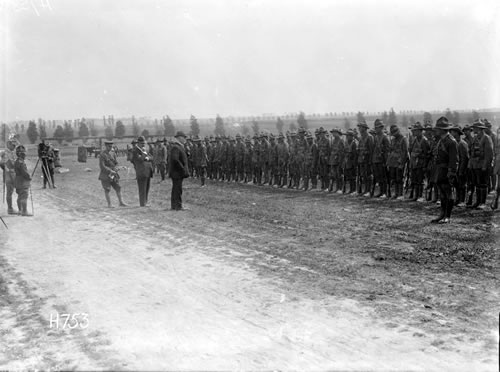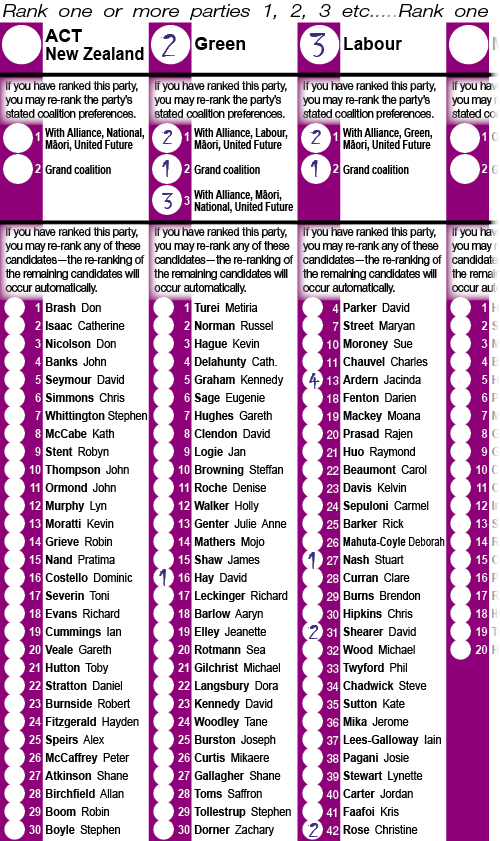mmp commission has perfect hearing

In Grand Company: In 1914, after declaring ‘All we are and all we have is at the disposal of the British government’, Prime Minister William Massey and his Reform Party formed a grand coalition with the Liberals, whose leader, Joseph Ward, is standing immediately behind him when photographed with New Zealand Tunnelling Company, France, 1918. image Alexander Turnbull Library
The primary motivation in producing the Mahurangi Magazine to champion the Mahurangi harbourscape.
Just an hour’s bus ride away from the city centre—or it will be once the Mahurangi Coastal Trail is complete—the Mahurangi is many Aucklanders’ favourite bolthole, a million miles from the metropolis.
In March, interest in the coastal trail helped attract five a half thousand visits to the website. Last month, when the subject switched to the review of the mixed member proportional electoral system, and to other less-than-local issues, the magazine received 1700 fewer visits.
The Mahurangi Magazine has campaigned for four and a half years for mixed member proportional, which it persists in doing because it considers that, long term, only the best of democratic processes will ensure the best long-term planning for places of outstanding natural beauty such as the Mahurangi Harbour. But it does so acutely aware that the credibility of the magazine could be compromised in the eyes of those who, for example, would prefer to see a return to the two-party system. Thus, in order to not squander its mandate to champion Mahurangi landscape, the magazine has rigorously attempted to promote only the most wholesome and necessary improvements to the electoral system.
Specifically, the magazine has strongly advocated for the addition of preference voting to New Zealand’s—since 1996—proportional electoral system. While it would be a stretch to claim that the readers accept the magazine’s case for introducing preference voting, the model certainly has been extensively canvassed in the Mahurangi. But what has not been well canvassed is the recent realisation that there was another, larger, elephant in the back of the room, obscured by the preference elephant—never mind the Māori roll and size-of-parliament elephants. Mixed member proportional, belatedly, brought direct democracy to the election of parties, but it fell short of bringing direct democracy to the election of coalitions. This, and the balance of the Mahurangi Magazine’s submission, yesterday, received a detailed hearing from the three commissioners: Sir Hugh Williams, Jane Hūria and Robert Peden. Examination of the submission was so comprehensive that the two political scientists assisting the Electoral Commission as expert advisers, Prof Nigel Roberts and Dr Therese Arseneau, appeared to have no further questions, supposing there had there been time for any.

Coalition Democracy: In 1996, for the first time, New Zealanders got to vote for their party of choice. It is now time for the logical next step, and for that control to be extended to coalition make-up.
Note 1 Sophisticated preferential voting systems allow voters to equally rank two or more candidates.
Note 2 Only the voter’s successful party preference carries with it any coalition or list preferences.
Ballot mock-up Mahurangi Magazine
With some rare and wonderful exceptions, participatory democracy can be an entirely dispiriting experience. Those who opt to be heard are reminded that time is limited, assured that their submissions have been read, and urged to speak to just the main points, only for a panel to proceed to listen mutely with barely concealed submission stupefaction, and fail to ask more than the most perfunctory question.
Auckland Council received nearly 10 000 submissions on its draft long-term plan, with more than 1500 submitters asking to be heard, from 10 April until 7 May. On 23 April, in an attempt to expedite the hearing process, multiple random groupings of citizens were arranged at tables in a large Aotea Centre conference room. Each group was presided over by an Auckland Council ward councillor, or two. An assurance by finance committee chairman Penny Webster that all submissions had been read seemed barely plausible—read by somebody, somewhere, possibly. If even by stint of great diligence the 1500-odd that were to be heard in person had been divvied up between the 20 councillors, it would average very little time for each to be studied. Nevertheless, the council’s press release categorically states:
All written and verbal submissions will be carefully considered.
In the event, councillors were not advised beforehand which submissions would be heard at their particular table. Told they would be arranged in groups according to issue, submitters arrived to find that council staff, unsurprisingly, had abandoned any such effort and were inviting submitters to ‘sit anywhere’.
The ‘forum’ format, if extremely well organised, could be an entirely satisfactory alternative to traditional hearings, where the number of speakers was so great that the time allocation for each was short that members of the hearing panel, or panels, could barely focus on a submission before it is time for the next. But why the organisers decided to convene multiple groups in one large space and subject each to the others’ sometimes-noisy exchanges is unclear. The results were decidedly unconvincing—and trying for those suffering even mild hearing impairment.
At the very least councillors would need to be provided a list of submissions ahead of time so that they could prepare meaningful questions. The Mahurangi Magazine experience was distinctly unconvincing and not helped when the councillors involved, Quax and Webster, at times appeared more interested in voicing their own opinions, rather than listening to those of their hapless submitters.
Serial hearing attendees tend to be realistic about (a.) the prospects for their submission—only one of 10 000—having any influence, and (b.) for the hearing to make a blind bit of difference to those prospects. The perfect hearing is that which gives the attendee confidence that a submission has been well comprehended and noted. Auckland Council might consider offering submitters the option of say five minutes before a panel of councillors, two hours engagement in a forum format, 15 minutes with an individual councillor, or 25 minutes with a council staff member.
As with most hearings, those held on the mixed member proportional review allowed for additional material to be presented. The Mahurangi Magazine chose to present a mock-up of its proposed party ballot paper, which consisted of a single-sided colour-printed A3 sheet. The parties and candidates were based on the 2011 general election. The editor went prepared with the following five-point list explaining the mock ballot paper, which had been marked by a hypothetical voter:
- The mock paper is single-sided—an actual ballot paper might have the rats and mice parties on the reverse side.
- The criteria for a party appearing on the ‘A side’, might be whether it was represented in Parliament in either of the previous two elections.
- Voters might be given the option of using such a ballot paper. Initially, a majority of voters may opt to use a simple ‘rank the parties’ paper.
- The object is to provide voters with a useful and user-friendly means of re-ranking candidates of interest. The mock party list is based on the previous election and for pragmatic reasons is limited to 30 places. The printed lists might start with candidates whose ranking is material, that is electorate seat incumbents with a margin of more than so many would be excluded. Parties nevertheless might be given the option of listing more candidates (last time National listed 75), and ballot papers bearing the extended party lists might be available to voters who specifically request them.
- With the advent of web-based voting systems, the user interface could be made much more user-friendly, and voters could choose to engage at the level of involvement that individually suited them.
In the event, the notes were largely redundant, thanks to the thoroughness of the commissioners in picking over the concept. The only omission was the criteria for parties appearing on the ‘A side’ of the ballot paper—that they were represented in Parliament in one or other of the last two elections. Four out of five is good going, but nor has the phone rung since to say the commissioners are anxious to question the Mahurangi Magazine further about its innovative concept for taming the party list, and for democratically determining the make-up of coalitions.
Arguably, the perfect submission is the one that needn’t have been written, much-less heard, in the first place.

Why, in a perfect world the perfect solution is always left behind a half-closed, half-open door? Open the door someone, please!